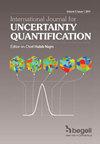基于方差的全局敏感性分析的极端学习机
IF 1.8
4区 工程技术
Q2 ENGINEERING, MULTIDISCIPLINARY
International Journal for Uncertainty Quantification
Pub Date : 2024-03-01
DOI:10.1615/int.j.uncertaintyquantification.2024049519
引用次数: 0
摘要
基于方差的全局敏感性分析(GSA)可为复杂模型提供大量信息。众所周知,这种方法的致命弱点是计算成本高,在实践中往往不可行。一个有吸引力的替代方法是分析代用模型的敏感性,目的是降低计算成本,同时保持足够的准确性。如果代用模型足够 "简单",适合于对其索布尔指数进行分析计算,那么 GSA 的成本基本上就降低到了代用模型的构建上。我们提出了一类新的稀疏权重极限学习机(SW-ELMs),将其视为 GSA 中的代理变量时,它们的 Sobol'指数可以用分析公式计算,与标准 ELMs 不同的是,它们可以得到这些指数的精确近似值。我们通过现场的传统基准和化学反应网络来说明这种方法的有效性。本文章由计算机程序翻译,如有差异,请以英文原文为准。
EXTREME LEARNING MACHINES FOR VARIANCE-BASED GLOBAL SENSITIVITY ANALYSIS
Variance-based global sensitivity analysis (GSA) can provide a wealth of information when applied to complex models. A well-known Achilles’ heel of this approach is its computational cost which often renders it unfeasible in practice. An appealing alternative is to analyze instead the sensitivity of a surrogate model with the goal of lowering computational costs while maintaining sufficient accuracy. Should a surrogate be “simple" enough to be amenable to the analytical calculations of its Sobol’ indices, the cost of GSA is essentially reduced to the construction of the surrogate. We propose a new class of sparse weight Extreme Learning Machines (SW-ELMs) which, when considered as surrogates in the context of GSA, admit analytical formulas for their Sobol’ indices and, unlike the standard ELMs, yield accurate approximations of these indices. The effectiveness of this approach is illustrated through both traditional benchmarks in the field and on a chemical reaction network.
求助全文
通过发布文献求助,成功后即可免费获取论文全文。
去求助
来源期刊

International Journal for Uncertainty Quantification
ENGINEERING, MULTIDISCIPLINARY-MATHEMATICS, INTERDISCIPLINARY APPLICATIONS
CiteScore
3.60
自引率
5.90%
发文量
28
期刊介绍:
The International Journal for Uncertainty Quantification disseminates information of permanent interest in the areas of analysis, modeling, design and control of complex systems in the presence of uncertainty. The journal seeks to emphasize methods that cross stochastic analysis, statistical modeling and scientific computing. Systems of interest are governed by differential equations possibly with multiscale features. Topics of particular interest include representation of uncertainty, propagation of uncertainty across scales, resolving the curse of dimensionality, long-time integration for stochastic PDEs, data-driven approaches for constructing stochastic models, validation, verification and uncertainty quantification for predictive computational science, and visualization of uncertainty in high-dimensional spaces. Bayesian computation and machine learning techniques are also of interest for example in the context of stochastic multiscale systems, for model selection/classification, and decision making. Reports addressing the dynamic coupling of modern experiments and modeling approaches towards predictive science are particularly encouraged. Applications of uncertainty quantification in all areas of physical and biological sciences are appropriate.
 求助内容:
求助内容: 应助结果提醒方式:
应助结果提醒方式:


